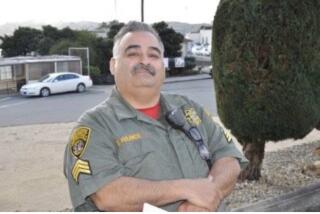Law Doesn’t Deter Cuban Smugglers
When Glynis Guerra Eligiga took the stand as the government’s star witness against two Cuban Americans accused of profiting from human despair, she seemed almost as terrified as she had been the day she watched her family die beneath the smugglers’ boat.
Eight months had passed since the 15-year-old’s mother, stepfather and, finally, her 3-year-old sister--a child suffering from Down syndrome--drowned after a wave swamped their overcrowded boat, all within sight of the beckoning lights of Miami Beach. Still, she couldn’t look the federal prosecutor in the eye as she relived the horror of that day, March 12, 1998. Despite her loss at the hands of the smugglers, despite the prosecutor’s incessant prodding, the girl wouldn’t repeat what she had earlier told investigators and a federal grand jury: that Abel and Nicandro Morejon had charged each of the 14 Cuban migrants they packed onto a 23-foot speedboat $1,500 for the journey.
In the end, Assistant U.S. Atty. Yvonne Rodriguez-Schack, who had told the jury that this was a case about “greed” and “the love of money,” conceded to the court that Glynis was too scared to testify. Federal agents later said the teenager feared retribution from the smugglers or others in Miami’s dominant Cuban American community.
The Morejon brothers pleaded guilty to lesser charges of migrant smuggling without profit the following day. U.S. District Judge James Lawrence King later sentenced them to minimum jail terms of less than four years. King’s track record for ruling in favor of Miami’s Cuban American community and migrants in general has been notable, and, apparently at the request of the Justice Department, he recused himself in January from the case of a far more famous Cuban castaway: Elian Gonzalez.
The case of the Morejon brothers is just one of more than half a dozen Cuban smuggling cases culled from federal court records in Miami and Fort Lauderdale, official documents in Havana and interviews on both sides of the Florida Straits. Together they show how the federal legal system in Miami--where nearly 1 million Cuban Americans hold political sway--serves as little deterrent to the region’s booming, multimillion-dollar trade in Cuban human cargo.
This is the flip side to Southern California, Arizona and Texas, where tens of thousands of illegal Mexican migrants are turned back while crossing into the United States each year. In the Southwest, popular sentiment runs strong against the migrants, and even stronger against the professional smugglers who bring them.
Here, almost all of the Cuban migrants who reach land are embraced. The law--the Cuban Adjustment Act of 1966--lets them stay if they reach landfall. The smugglers who brought them--often with some of their own relatives--are breaking other laws, but they are commonly cast as heroes.
This is the scenario in Miami: sympathetic juries and judges, intimidated witnesses, an understaffed U.S. Border Patrol anti-smuggling unit, and conflicting U.S. policies that treat the smugglers as criminals but their clients as political refugees. These have combined to encourage a clandestine trade over the high seas that has killed scores, traumatized hundreds and brought thousands of new migrants into the United States illegally in the last several years, according to court records and federal law enforcement agents.
In almost every case that comes to trial, federal prosecutors seek--with little success--to bar emotional, political arguments by defense attorneys, who often are Cuban refugees themselves. The lawyers routinely try to convince juries that their clients have rescued Cubans who would rather die than return to Fidel Castro’s Communist-run island.
But the Cuban president also has politicized the smuggling issue, placing it at center stage in his attacks on the U.S. after Elian arrived here last year on an ill-fated smuggler’s journey. The Cuban leader has charged that Miami’s Cuban American lobby, which he dubs a “mafia,” is encouraging--even helping finance--the smuggling trade to show a continuing exodus from his country.
The lobby denies the charge. Its leaders have publicly condemned the smuggling trade and laid full blame for it on Castro’s repressive policies.
In a shortwave transmission to Cuba by the Cuban American National Foundation--the most powerful of the lobbying groups--a somber voice warns: “Brother, don’t risk your life or that of your loved ones by setting out to sea. Don’t place your children’s lives in the hands of unscrupulous smugglers who are only looking out for themselves.”
But U.S. Border Patrol officials, who are responsible for enforcing anti-smuggling laws designed to prevent journeys that have killed dozens of migrants in the last year alone--including Elian’s mother and 10 others--tend to agree with much of Castro’s assessment.
Those officials assert that the overwhelming majority of the smugglers’ clients are not political refugees but economic migrants, who are no different from Haitians, Dominicans or Mexicans seeking a better life in America.
And they say Miami’s federal court system has worked against U.S. law enforcement’s efforts to stop a trade that has grown exponentially in the last several years.
Federal court records here support that view. In the last year alone, they show:
* Two Cuban American smugglers who faced possible life imprisonment on conspiracy charges after they took full responsibility for the deaths of 14 Cuban migrants--men, women and children who drowned in 1998 when a wave hit the smugglers’ overloaded 30-foot speedboat--were given just 16 months in jail by a federal judge.
* A 52-year-old Cuban American smuggler faced the death penalty when he pleaded guilty in March to staging a journey that left one Cuban migrant washed up dead on Golden Beach, Fla. Four days after Miguel Rolando Yanes entered his plea, the Coast Guard caught him on a stolen boat, apparently on another human-smuggling run. Despite that, Yanes was sentenced last month to only 78 months in prison--the longest term on record here for anyone convicted of smuggling Cuban migrants.
* Three Cuban American members of a smuggling ring that prosecutors estimated had averaged $150,000 a voyage were each facing 111 years of jail time before they went on trial last year for endangering the lives of 35 illegal migrants by putting them on a boat built to carry no more than a dozen. But they were each given just less than four years in prison by King--a Cold War-era appointee who came to the bench a year after Castro’s revolution--after a jury here acquitted them on the more serious charges of smuggling for profit.
By contrast, in Cuba, where the maximum penalty for smuggling humans is death, judges routinely hand out life sentences. The government there boasts that more than 50 alleged smugglers--U.S. residents among them--are now awaiting trial.
At the core of the problem here, federal judges, prosecutors and agents say, is a U.S. policy that Cubans--and only Cubans--are no longer “illegal” migrants the moment they touch U.S. soil. Under 1994 and 1995 immigration treaties with Cuba establishing what informally is known as the “wet foot/dry foot” policy, Cubans caught at sea are sent back unless they can prove persecution on the island.
That policy grew out of the Cuban Adjustment Act, and it is strongly endorsed by Miami’s well-funded Cuban American lobby.
But in recent months, the Cuban government contends that known smugglers, including some with criminal records for armed robbery and attempted murder in Cuba, have been freed in Florida by U.S. authorities after they had to send home “wet foot” witnesses caught at sea.
U.S. law enforcement officials concede that. Most professional smugglers are U.S. residents who are returned to America when intercepted at sea, while their human cargo must be sent back to Cuba. Without witnesses, Border Patrol agents say, cases involving smugglers caught or swamped at sea are virtually impossible to prove in federal court here.
In one such case during the last week of March, the Cuban government reported that 24 men, women and children were smuggled out of the country on five illegal boat journeys organized by two men who had extensive criminal records. The Coast Guard intercepted all five boats at sea and repatriated 20 of those on board.
Of the four who were taken to Miami, two needed hospitalization, and two were the smugglers--whom Havana had identified by name. Border Patrol sources confirmed the circumstances of the case but not the smugglers’ identities. They said no criminal charges would be brought against the men, both legal U.S. residents, because the key witnesses were back in Cuba.
Prosecutors rely on testimony from Border Patrol agents and Coast Guard officers to prove simple migrant-smuggling charges. But for the more serious charges of conspiracy or smuggling for profit, they need testimony from the paying customers--often relatives in the U.S. or the migrants themselves.
Steve Quinones, who supervises an eight-member anti-smuggling unit of the Border Patrol that must police all of Florida, Georgia and South Carolina, said that even when prosecutors have witnesses and win convictions, the light sentences have further eroded any deterrent.
“Would we like to see stiffer penalties? Yes,” he said. “Can we do anything about it? No.”
In fact, in Miami, where the smugglers--and even jurors who judge them--are often former Cuban rafters and refugees themselves, charges routinely are reduced or dismissed, and judges usually dole out minimum sentences.
So pronounced is that phenomenon that defense lawyers have strenuously argued to have migrant-smuggling cases transferred to Miami from Fort Lauderdale, just 20 miles away, where Cubans do not predominate.
A case in point is last year’s trial of the three alleged profiteers who jammed 35 migrants--11 children, 13 women and 11 men--onto a 29-foot speedboat with just eight life vests and little food or water near the Cuban coast in June 1998.
They ran out of gas and drifted at sea for several days, endangering the lives of all, testimony showed. And the smugglers never used the radio or mobile phone on board to call the U.S. Coast Guard for rescue--not even after a passing freighter spotted them, fed them and offered to make the call for them.
When the freighter captain alerted the Coast Guard anyway, officers said they could smell the boat before they saw it 12 miles off the Florida coast: “The boat was covered with all manner of human waste,” prosecutors later recalled.
In opening the government’s case against Jose Lima, Miguel Broche-Ortiz and Carlos Ruiz-Rodriguez--two of them former rafters--before a Miami federal jury last year, Assistant U.S. Atty. Jacqueline Hogan Scola told the jury that it was “a conspiracy for money, for personal profit and for commercial gain to bring these 35 illegal, desperate Cuban immigrants to this country for somewhere between $7,000 and $9,000 a head.”
“This was not some humanitarian effort with lofty ideals. Nor was it a rescue mission to scoop rafters at sea.”
Scola even had a star witness, Francisco Cruz, who testified that he had agreed to pay Lima $23,000 to bring his wife, child and brother from Cuba.
But sympathy for the Cuban cause ran strong in the courtroom.
After denying the standard request from prosecutor Scola to bar political arguments by the defense, Judge King added: “If he [the defense attorney] simply starts into a tirade that Castro is an evil man, frankly, I don’t think it needs to be said. I would imagine everybody here knows it.”
The jury, which also heard testimony from other survivors who refused to testify that money had changed hands, acquitted all three men on smuggling-for-profit charges, which carried stiff penalties. After a conviction on other “alien smuggling” charges, prosecutor Scola told journalists: “Given the politics of these cases, any conviction at all is a victory.”
Even more telling was the debate that ensued during the sentencing hearing for the two men who pleaded guilty to the smuggling journey that killed 14 migrants Dec. 18, 1998--the deadliest such voyage on record.
Prosecutor Joan Silverstein had told U.S. District Judge Donald Graham that it was “a typical case of alien smuggling,” offering evidence that money had changed hands and that the smugglers had “recklessly endangered” the lives of all on board.
The defense argued that it was anything but typical.
One of the accused, Pedro Julio Guevara, a former rafter, testified that he sought only to pick up his wife, child, brother, sister-in-law and niece from a deserted Bahamian island where they’d been taken by a Cuban fisherman. But when he and the boat’s owner, Francisco Gomez, landed there, they found not only Guevara’s family but 16 other migrants desperate for a ride to Florida.
Gomez testified that initially he refused, telling the group it would be too dangerous. Eventually, he said, he acceded in order to save their lives.
But in weighing their sentence, it was Judge Graham who framed the recurring problem in all migrant smugglers’ cases here--the fundamental conflict in U.S. policies on Cuban migration and migrant smuggling.
“I hate to raise another issue,” he said, “but should the court consider in any way the fact individuals who reach the shores are, for all practical purposes, able to remain in the United States? In fact, it was the defendants who were prosecuted, not those who came into the country illegally.
“What type of deterrent is that? . . . What kind of signal does the government send--’If you get here you get to stay’? . . . Does the government encourage people to be brought in?”
Later in the hearing, Graham added: “Generally you punish conduct, illegal and unlawful conduct. . . . But in trying to determine the nature and harm caused, considering the government’s position is a little troublesome.”
And on that point, even the prosecutor agreed, saying: “I think there are some troublesome parts to the United States’ policy on Cuba. But its policy as to smuggling aliens from Cuba is not vague.”
Silverstein then beseeched the judge to hand down as tough a sentence as the law permits.
“The community needs to be sent a message that this court will not accept this conduct,” she argued. “If such a message is sent, no lives like this will be lost in the future.”
Graham gave both men 16 months in jail. The sentence was so light that prosecutors initially indicated that they would file a rare appeal, but they did not pursue one.
That was on June 11, 1999--halfway through a year, Coast Guard records show, in which at least 60 other Cuban migrants died at sea.
More to Read
Start your day right
Sign up for Essential California for news, features and recommendations from the L.A. Times and beyond in your inbox six days a week.
You may occasionally receive promotional content from the Los Angeles Times.






